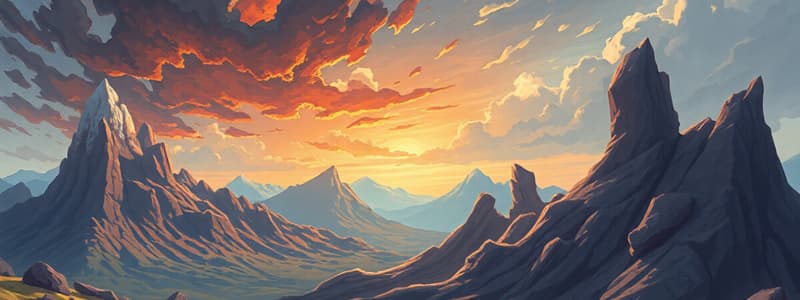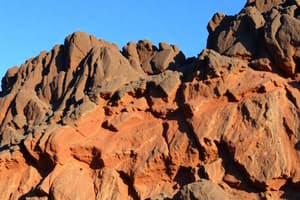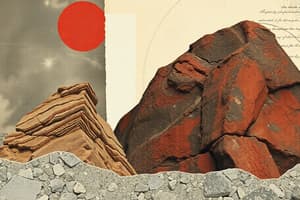Podcast
Questions and Answers
What is the primary difference between magma and lava?
What is the primary difference between magma and lava?
- Magma is found on the Earth's surface, while lava is beneath the surface.
- Magma is molten rock beneath the Earth's surface, while lava is molten rock that erupts onto the surface. (correct)
- Magma forms sedimentary rocks, while lava forms metamorphic rocks.
- Magma cools rapidly, while lava cools slowly.
Metamorphic rocks are formed from the cooling and solidification of magma or lava.
Metamorphic rocks are formed from the cooling and solidification of magma or lava.
False (B)
What are the three main types of rocks involved in the rock cycle?
What are the three main types of rocks involved in the rock cycle?
igneous, sedimentary, and metamorphic
The process by which sediments are transformed into solid rock is called _, and _.
The process by which sediments are transformed into solid rock is called _, and _.
Match the following rock types with their primary formation process.
Match the following rock types with their primary formation process.
Flashcards
What is the rock cycle?
What is the rock cycle?
The process by which rocks are formed, transformed, and recycled over time, driven by geological forces like weathering, erosion, heat, and pressure.
What are igneous rocks?
What are igneous rocks?
Rocks formed from the cooling and solidification of magma or lava, classified by texture (e.g., coarse or fine-grained) and composition (e.g., felsic, mafic).
What are sedimentary rocks?
What are sedimentary rocks?
Rocks formed from the accumulation and cementation of sediments (rock fragments, minerals, organic material).
What are metamorphic rocks?
What are metamorphic rocks?
Signup and view all the flashcards
What is foliation in metamorphic rocks?
What is foliation in metamorphic rocks?
Signup and view all the flashcards
Study Notes
Introduction to the Rock Cycle
- The rock cycle is a continuous process detailing transitions between igneous, sedimentary, and metamorphic rocks.
- Geological processes like weathering, erosion, compaction, heat, and pressure drive these transitions.
- Rocks are continually formed, transformed, and recycled over vast time spans.
Igneous Rocks
- Igneous rocks form from the cooling and solidifying of magma or lava.
- Magma is molten rock below the surface, lava above.
- Classified by texture (e.g., coarse-grained, fine-grained) and composition (e.g., felsic, intermediate, mafic, ultramafic).
- Examples include granite, basalt, and obsidian.
- Cooling rate influences crystal size and rock texture.
Sedimentary Rocks
- Sedimentary rocks result from the accumulation and cementation of sediments.
- Sediments are small pieces of rock, minerals, or organic material, transported and deposited by agents like water, wind, ice.
- Processes like compaction and cementation transform sediments into solid rock.
- Often layered, containing fossils revealing past environments.
- Classified by composition, texture, and origin (e.g., clastic, chemical, organic).
- Examples include sandstone, limestone, and shale.
Metamorphic Rocks
- Metamorphic rocks form from the alteration of existing rocks (igneous, sedimentary, or metamorphic) due to high temperature and pressure within Earth's crust.
- Metamorphism changes the rock's mineralogy, texture, and sometimes chemical composition without melting.
- Textures and structures vary based on pressure and temperature intensity.
- Foliation (layered appearance) is common in high-pressure metamorphic rocks.
- Other textures like hornfels may also appear.
- Examples include marble, slate, and gneiss.
Interconnections in the Rock Cycle
- Igneous rocks weather and erode into sediments, forming sedimentary rocks.
- Sedimentary rocks transform into metamorphic rocks under heat and pressure.
- Metamorphic rocks melt to form magma, which solidifies into igneous rocks.
- This continuous cycle illustrates Earth's dynamic surface.
Factors Influencing the Rock Cycle
- Temperature and pressure significantly affect rock cycle transitions.
- Igneous rock texture is influenced by cooling and crystallization rates.
- Sedimentary rock composition is affected by weathering and transport mechanisms.
- Metamorphic rock properties depend on the intensity of heat and pressure.
- Geological events and environmental changes also impact cycle processes.
Summary of the Rock Cycle
- The rock cycle unifies geological transformations in Earth's materials.
- It connects rock formation, alteration, and breakdown, demonstrating ongoing recycling across vast geologic time.
- Each stage provides insights into Earth's history, geological processes, and planetary evolution.
Studying That Suits You
Use AI to generate personalized quizzes and flashcards to suit your learning preferences.




